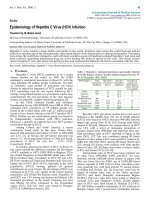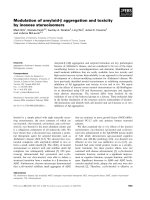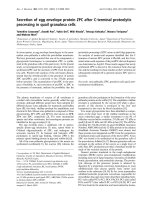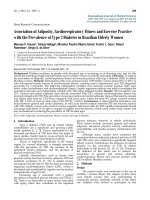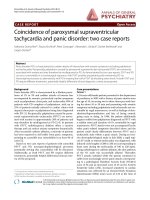Báo cáo y học: " Seropositivity of Hepatitis B virus and Hepatitis C virus dual Infection among blood donors in Nyala Teaching Hospital" pot
Bạn đang xem bản rút gọn của tài liệu. Xem và tải ngay bản đầy đủ của tài liệu tại đây (183.38 KB, 2 trang )
BioMed Central
Page 1 of 2
(page number not for citation purposes)
Virology Journal
Open Access
Short report
Seropositivity of Hepatitis B virus and Hepatitis C virus dual
Infection among blood donors in Nyala Teaching Hospital
Mustafa Abdalla Ali Abou*
1,2
and Yassir Mohammed Eltahir
3
Address:
1
Department of Laboratories Administration, State Ministry of Health, South Dar Fur, Nyala, Sudan,
2
UNAMID Level 1 Clinic, Nyala,
South Dar Fur, Sudan and
3
Department of Preventive Medicine & Veterinary Public Health, Faculty of Veterinary Science, University of Nyala,
Nyala, Sudan
Email: Mustafa Abdalla Ali Abou* - ; Yassir Mohammed Eltahir -
* Corresponding author
Abstract
The aim of this study was to determine the seropositivity of Hepatitis B virus (HBV) and Hepatitis
C virus (HCV) dual infection among blood donors in Nyala Teaching Hospital, which is the biggest
(400 beds) hospital in great Dar Fur of Western Sudan. 400 blood donors were tested serologically
for the detection of HBsAg and anti-HCV antibodies. Only one (0.25%) out of the 400 examined
blood donors was detected reactive for both HBsAg and anti-HCV antibodies. The study
concluded that the seropositivity of HBV and HCV dual infection among population studied is
uncommon.
Introduction
Dual infection with HBV and HCV leads to more aggres-
sive liver disease [1]. In addition to chronic liver disease,
coinfection of HBV and HCV is frequently found in injec-
tion drug users (IDU, 42.5%) [2], patients on hemodialy-
sis (3.7%) [3], patients undergoing organ transplantation
(8%) [4], HIV-positive individuals (66%) [5], and beta-
thalassemia patients (10%) [6], which means that those
are the high risk population for infection of HBV and HCV
concurrently. As HBV and HCV have the same transmis-
sion routes, dual infection may occur [7]. No published
data of the seropostivity of HBV and HCV dual infection
in great Dar Fur, and may be in the large Sudan. So the
current study amied to determine the seropositivity of
HBV and HCV dual infection among blood donors in
Nyala Teaching Hospital.
Materials and methods
This study was conducted during the period from May to
July 2007, in Nyala Teaching Hospital, which is the big-
gest (400 beds) hospital in great Dar Fur, and according to
the blood bank records 3600 pints of blood are collected
annually from blood donors. 400 male, apparently
healthy blood donors were randomly selected and
enrolled in this study. Five ml of blood were drawn from
each subject; sera were separated, aliquoted, labeled
within two hours of collection and stored at -70°C. Serum
samples initially tested for HBsAg and anti-HCV antibod-
ies with Immunochromatographic Test (ICT) from
Advanced Quality, then screened with a 3
rd
generation
Enzyme Linked Immunosorbent Assay (ELISA), Equi-
HBsAg and EIAgen anti-HCV antibodies from Equibar
and Adalits respectively.
Published: 22 December 2009
Virology Journal 2009, 6:227 doi:10.1186/1743-422X-6-227
Received: 5 November 2009
Accepted: 22 December 2009
This article is available from: />© 2009 Abou and Eltahir; licensee BioMed Central Ltd.
This is an Open Access article distributed under the terms of the Creative Commons Attribution License ( />),
which permits unrestricted use, distribution, and reproduction in any medium, provided the original work is properly cited.
Publish with BioMed Central and every
scientist can read your work free of charge
"BioMed Central will be the most significant development for
disseminating the results of biomedical research in our lifetime."
Sir Paul Nurse, Cancer Research UK
Your research papers will be:
available free of charge to the entire biomedical community
peer reviewed and published immediately upon acceptance
cited in PubMed and archived on PubMed Central
yours — you keep the copyright
Submit your manuscript here:
/>BioMedcentral
Virology Journal 2009, 6:227 />Page 2 of 2
(page number not for citation purposes)
Results
A total 400 male blood donors were enrolled in this study,
with a mean age of 33 years and an age range of 18-49
years. The seropositivity of HBV and HCV dual infection
was detected in only one (0.25%) blood donor.
Discussion
Surveillance of carriers of viral hepatitis is essential to
assess the burden of the disease in the population.
Although dual infection with HBV and HCV is not
uncommon in the geographic areas where a high endemic
level of both infections is reported, such as Southeast Asia
and the Mediterranean, the role of this dual infection in
the pathogenesis of chronic liver disease is still controver-
sial (8,9,10,11). Despite dual infection with HBV and
HCV leads to mutual suppression of both viruses, several
studies have suggested that HBV and HCV infection may
be associated with a more severe clinical presentation
[12,13]. The findings of this study showed that the serop-
ositivity of dual infection of HBV and HCV among blood
donors in Nyala Teaching Hospital was (0.25%), this per-
cent is in accordance with the endemic level of both
viruses in South Dar Fur State, Sudan, in which the sero-
prevalence of HBV is of an intermediate level (6.25%) and
HCV seroprevalence of low level (0.65%)[14]. Dual infec-
tion of HBV and HCV in Nyala when compared with stud-
ies conducted in other parts of Sudan, there is afew
published data indicating that dual infection of HBV and
HCV was never detected in Northern Sudan[15]. So dual
infection of HBV and HCV is uncommon in Nyala and
may be in the large Sudan due to the endemic level of
both viruses.
Conclusion
The study concluded that the seropositivity of HBV and
HCV dual infection among population studied is uncom-
mon.
Competing interests
The authors declare that they have no competing interests.
Authors' contributions
MAAA carried out the whole work of the study. YME
supervised the work of the study. All authors read and
approved the final manuscript.
References
1. Devi KS, Singh NB, Mara J, Singh TB, Singh YM: Seroprevalence of
Hepatitis B virus and Hepatitis C virus among hepatic disor-
ders and injecting users in Manipur-A preliminary report.
Indian Journal of Medical Microbiology 2004, 22(2):136-137.
2. Pallas JR, Farinas-Alvarez C, Prieto D, Delgado-Rodriguez M: Coin-
fection by HIV, Hepatitis B and Hepatitis C in imprisoned
injecting drug users. Europe Journal of Epidemiology 1999,
15:699-704.
3. Reddy GA, Dakshinamurthy KV, Neelaprasad P, Gangadhar T, Lak-
shmi V: Prevalence of HBV and HCV dual infection in patients
on hemodialysis. Indian Journal of Medical Microbiology 2005,
23:41-43.
4. Aroldi A, Lampertico P, Montagnino G, Passerini P, Villa M, Campise
MR, Lunghi G, Tarantino A, Cesana BM, Messa PG, Ponticelli C: Nat-
ural history of Hepatitis B and C in renal allograft recipients.
Transplantation 2005, 79:1132-1136.
5. Kalinowska-Nowak A, Bociaga-Jasik M, Garlicki A, Skwara P: Preva-
lence of hepatotropic viruses HBV and HCV in HIV-infected
patients from Southern region of Poland. Acta virologica 2000,
44:23-28.
6. Irshad M, Peter S: Spectrum of viral hepatitis in thalassemic
children receiving multiple blood transfusions. Indian Journal of
Gastroenterology 2002, 21:183-184.
7. Liaw YF: Hepatitis C virus superinfection in patients with
chronic Hepatitis B virus infection. Journal of Gastroenterology
2002, 37:65-68.
8. Ayoola EA, Gadour MO: Hepatocellular carcinoma in Saudi
Arabia: role of hepatitis B and C infection. Journal of Gastroen-
terology and Hepatology 2004, 19:665-669.
9. Castillo I, Rodriguez-Inigo E, Lopez-Alcorocho JM, Bartolome J, Pardo
M, Carreno V: Comparative study on the clinical and virologi-
cal characteristics among patients with single occult hepati-
tis B virus (HBV), single occult hepatitis C virus (HCV) and
occult HBV and HCV dual infection. Journal of Medical Virology
2007, 79:236-241.
10. Liu Z, Hou J: Hepatitis B virus (HBV) and hepatitis C virus
(HCV) dual infection. International Journal of Medical Science
2006,
3:57-62.
11. Shi J, Zhu L, Liu S, Xie WF: A meta-analysis of case control stud-
ies on the combined effect of hepatitis B and C virus infec-
tions in causing hepatocellular carcinoma in China. British
Journal of Cancer 2005, 92:607-612.
12. Crespo J, Lozano JL, de la Cruz F, Rodrigo L, Rodriguez M, San-Miguel
G, ArtiSano E, Pons-Romero F: Prevalence and significance of
hepatitis C viremia in chronic active hepatitis B. American Jour-
nal of Gastroenterology 1994, 89:1147-1151.
13. Fattovich G, Tagger A, Brollo L, Giustina G, Pontisso P, Realdi G,
Alberti A, Ruol A: Hepatitis C virus infection in chronic hepati-
tis B virus carriers. Journal of Infectious Diseases 1991, 163:400-402.
14. Abou MA, Eltahir YM, Ali AS: Seroprevalence of Hepatitis B
virus and Hepatitis C virus among blood donors in Nyala,
South Dar Fur, Sudan. Virology Journal 2009, 6:146.
15. Nagi AM, Altyeb HA, Ahmed AM: Seroprevalence of Hepatitis B
and C Viral Infections among blood donors in Shendi, River
Nile State, Sudan. Research Journal of Medicine and Medical Sciences
2007, 2(2):122-126.
